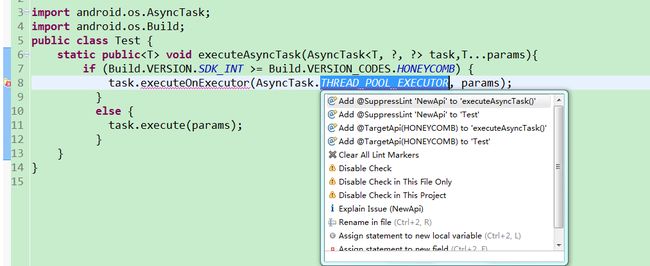我的Android进阶之旅------>Android中高低API版本兼容使用@TargetApi或者@SuppressLint("NewApi")
Android中高低API版本兼容使用@TargetApi或者@SuppressLint("NewApi")
例如:AndroidManifest.xml中,我们配置了sdk版本的最低为9,目标sdk为19
<uses-sdk
android:minSdkVersion="9"
android:targetSdkVersion="19" />
当我们使用了大于sdk版本为9的API时候,编译器就会提示警告。例如:
import android.os.AsyncTask;
import android.os.Build;
public class Test {
static public<T> void executeAsyncTask(AsyncTask<T, ?, ?> task,T...params){
if (Build.VERSION.SDK_INT >= Build.VERSION_CODES.HONEYCOMB) {
task.executeOnExecutor(AsyncTask.THREAD_POOL_EXECUTOR, params);
}
else {
task.execute(params);
}
}
}
警告如下:
Multiple markers at this line - Field requires API level 11 (current min is 9): android.os.AsyncTask#THREAD_POOL_EXECUTOR - Call requires API level 11 (current min is 9): android.os.AsyncTask#executeOnExecutor
截图如下截图如下:
Multiple markers at this line - Field requires API level 11 (current min is 9): android.os.AsyncTask#THREAD_POOL_EXECUTOR - Call requires API level 11 (current min is 9): android.os.AsyncTask#executeOnExecutor
解决方法是在方法上加上@SuppressLint("NewApi")或者@TargetApi()。
那他们之间有什么区别呢,很简单,
@SuppressLint("NewApi")屏蔽一切新api中才能使用的方法报的android lint错误
@TargetApi() 只屏蔽某一新api中才能使用的方法报的android lint错误。
使用@TargetApi(Build.VERSION_CODES.HONEYCOMB)方式解决
import android.annotation.TargetApi;
import android.os.AsyncTask;
import android.os.Build;
@TargetApi(Build.VERSION_CODES.HONEYCOMB)
public class Test {
static public<T> void executeAsyncTask(AsyncTask<T, ?, ?> task,T...params){
if (Build.VERSION.SDK_INT >= Build.VERSION_CODES.HONEYCOMB) {
task.executeOnExecutor(AsyncTask.THREAD_POOL_EXECUTOR, params);
}
else {
task.execute(params);
}
}
}
使用@SuppressLint("NewApi")方式解决
import android.annotation.SuppressLint;
import android.os.AsyncTask;
import android.os.Build;
public class Test {
@SuppressLint("NewApi")
static public<T> void executeAsyncTask(AsyncTask<T, ?, ?> task,T...params){
if (Build.VERSION.SDK_INT >= Build.VERSION_CODES.HONEYCOMB) {
task.executeOnExecutor(AsyncTask.THREAD_POOL_EXECUTOR, params);
}
else {
task.execute(params);
}
}
}
当然,不管你使用了哪个注解,作用仅仅是屏蔽android lint错误,所以在方法中还要判断版本做不同的操作,例如上述代码。
public class Test {
@TargetApi(Build.VERSION_CODES.HONEYCOMB)
static public <T> void executeAsyncTask(AsyncTask<T, ?, ?> task,
T... params) {
// 当版本大于Build.VERSION_CODES.HONEYCOMB时调用的方法
if (Build.VERSION.SDK_INT >= Build.VERSION_CODES.HONEYCOMB) {
task.executeOnExecutor(AsyncTask.THREAD_POOL_EXECUTOR, params);
}
// 当版本小于Build.VERSION_CODES.HONEYCOMB时调用的方法
else {
task.execute(params);
}
}
}
PS: What is better: @SuppressLint or @TargetApi?
(地址:http://stackoverflow.com/questions/14341042/what-is-better-suppresslint-or-targetapi)
====================================================================================
作者:欧阳鹏 欢迎转载,与人分享是进步的源泉!
转载请保留原文地址:http://blog.csdn.net/ouyang_peng
====================================================================================

